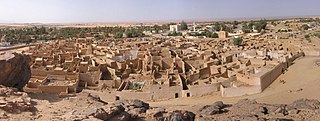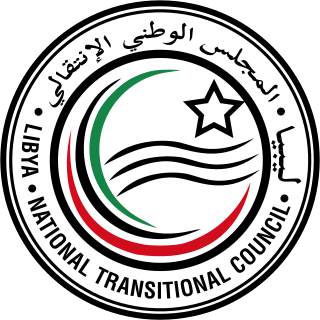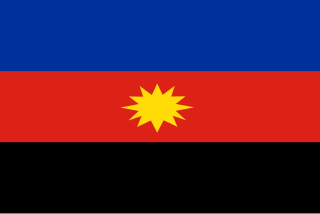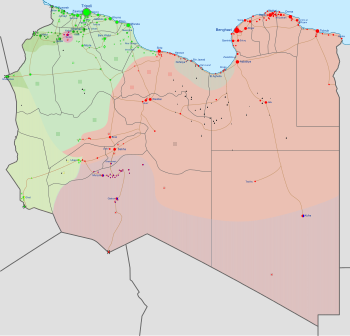
Fezzan is the southwestern region of modern Libya. It is largely desert, but broken by mountains, uplands, and dry river valleys (wadis) in the north, where oases enable ancient towns and villages to survive deep in the otherwise inhospitable Sahara Desert. The term originally applied to the land beyond the coastal strip of Africa proconsularis, including the Nafusa and extending west of modern Libya over Ouargla and Illizi. As these Berber areas came to be associated with the regions of Tripoli, Cirta or Algiers, the name was increasingly applied to the arid areas south of Tripolitania.

Ubari or Awbari is a Tuareg Berber–speaking oasis town and the capital of the Wadi al Hayaa District, in the Fezzan region of southwestern Libya. It is in the Idehan Ubari, a Libyan section of the Sahara Desert. It was the capital of the former baladiyah (district) called Awbari, in the southwest of the country.

Ghat is the capital of the Ghat District in the Fezzan region of southwestern Libya, located just east of the Algerian border.

Murzuk, Murzuq, Murzug or Merzug is an oasis town and the capital of the Murzuq District in the Fezzan region of southwest Libya. It lies on the northern edge of the Murzuq Desert, an extremely arid region of ergs or great sand dunes which is part of the greater Sahara Desert.

Ghat is one of the districts of Libya. Its capital is Ghat. To the west, Ghat borders two provinces of Algeria: Tamanghasset in the far southwest, and Illizi Province. It also has a short border with the Agadez Department of Niger in the far south. Domestically, it borders Wadi Al Shatii in north, Wadi Al Hayaa in northeast and Murzuq in the east.

The First Libyan Civil War was an armed conflict in 2011 in the North African country of Libya that was fought between forces loyal to Colonel Muammar Gaddafi and rebel groups that were seeking to oust his government. It erupted with the Libyan Revolution, also known as the 17 February Revolution. The war was preceded by protests in Zawiya on 8 August 2009 and finally ignited by protests in Benghazi beginning on Tuesday, 15 February 2011, which led to clashes with security forces who fired on the crowd. The protests escalated into a rebellion that spread across the country, with the forces opposing Gaddafi establishing an interim governing body, the National Transitional Council.
The Fezzan campaign was a military campaign conducted by the National Liberation Army to take control of southwestern Libya during the Libyan Civil War. During April to June 2011, anti-Gaddafi forces gained control of most of the eastern part of the southern desert region during the Cyrenaican desert campaign. In July, Qatrun changed to anti-Gaddafi control on 17 July and back to pro-Gaddafi control on 23 July. In late August, anti- and pro-Gaddafi forces struggled for control of Sabha.

The aftermath of the First Libyan Civil War has been characterized by marked change in the social and political order of Libya after the overthrow and killing of Muammar Gaddafi in the civil war that was fought in Libya in 2011. The country has been subject to ongoing proliferation of weapons, Islamic insurgencies, sectarian violence, and lawlessness, with spillovers affecting neighboring countries including Mali.

Following the end of the First Libyan Civil War, which overthrew Muammar Gaddafi, there was violence involving various militias and the new state security forces. This violence has escalated into the Second Libyan Civil War (2014–2020).

The National Movement for the Liberation of Azawad or the Azawad National Liberation Movement, formerly the National Movement of Azawad, is a political and military organisation based in Azawad in northern Mali.

The Libyan Army is the brand for a number of separate military forces in Libya, which were under the command of the internationally recognised Government of National Accord (GNA).
The 2012 Sabha conflict started in the aftermath of the Libyan civil war, and involved armed clashes between the Tubu and Abu Seif tribes in Sabha, a city of almost 100,000 in the region of Fezzan, Libya. It happened after February 2012 clashes in Kufra, that involved the Tubu people, too. On 27 March, Jomode Elie Getty charged the clashes as "genocide". A Paris-based Tabu official, Jomode Elie Getty, who was an official with the NTC but resigned on Tuesday, accused the NTC of siding with Arabs in attacks on Tabu tribesmen. He called for U.N. intervention.

The Toubou Front for the Salvation of Libya is a group created in mid-2007 to defend the rights and interests of the Toubou people in Libya. It is led by Issa Abdel Majid Mansur, a Libyan Toubou tribal leader, and has its headquarters in Oslo, Norway. The group, which had participated in the Libyan Civil War on the NTC side, was disbanded in August 2011, with the fall of Tripoli. Despite that, the group was revitalized in March 2012, with the aim of "protect the Toubou from ethnic cleansing", following early 2012 deadly clashes between Toubou and Arab militias in southern Libya, which caused the loss of hundreds of lives.

Gaddafi loyalism, in a wider political and social sense also known as Green resistance, consists of sympathetic sentiment towards the overthrown government of Muammar Gaddafi, who was killed in October 2011. It has been responsible for some of the ongoing violence in Libya, though the degree of its involvement has been disputed in a number of instances.

The Libyan Crisis refers to the current humanitarian crisis and political-military instability occurring in Libya, beginning with the Arab Spring protests of 2011, which led to a civil war, foreign military intervention, and the ousting and death of Muammar Gaddafi. The civil war's aftermath and proliferation of armed groups led to violence and instability across the country, which erupted into renewed civil war in 2014. The crisis in Libya has resulted in tens of thousands of casualties since the onset of violence in early 2011. During both civil wars, the output of Libya's economically crucial oil industry collapsed to a small fraction of its usual level, with most facilities blockaded or damaged by rival groups, despite having the largest oil reserves of any African country. On October 23, 2020, parties signed a permanent ceasefire.
This is a detailed timeline of the Second Libyan Civil War which lasted from 2014 to 2020.
On 18 May 2017, an attack was launched by militia men of the town of Misrata and Benghazi Defense Brigades against the Brak al-Shati Airbase controlled by LNA forces. LNA sources claimed 141 people, including 103 soldiers and numerous civilians were killed as a result of the raid. The base was completely overrun and partially destroyed along with numerous aircraft in the base. Accusations of executions of surrendering forces lead to international condemnation of GNA forces.

In late January 2019, the Libyan National Army (LNA) led by Marshal Khalifa Haftar launched an offensive to take control of the city of Sabha and the rest of southern Libya from the internationally recognised Government of National Accord (GNA) and local factions. Officially, the LNA announced that the reason for the operation was to remove terrorists, Chadian rebel groups, and to secure the border, but it has expanded Haftar's territorial control and acquired him oil fields near Sabha. It has also restarted some interethnic conflicts as the LNA has allied with local Arab tribes, while the Tuareg and Toubou tribal militias are loyal to the GNA.
The Ubari conflict was a territorial dispute between the Tuareg and Tubu tribes over control of the town of Ubari, located near the oasis town of Sabha, Libya.

In 2016, the Front for Change and Concord in Chad (FACT) and the Military Command Council for the Salvation of the Republic (CCMSR) began a rebellion against the Chadian government. From their rear bases in southern Libya, FACT and CCMSR have launched offensives and raids into Northern Chad seeking to overthrow the government of former president Idriss Déby, who had been in power since a December 1990 coup. Other rebel groups are also involved in the insurgency, though to a lesser extent.
















